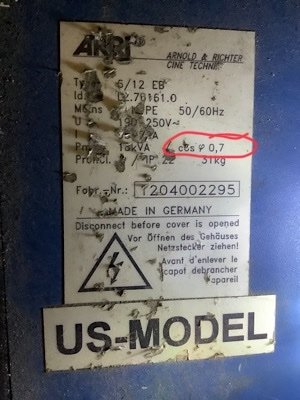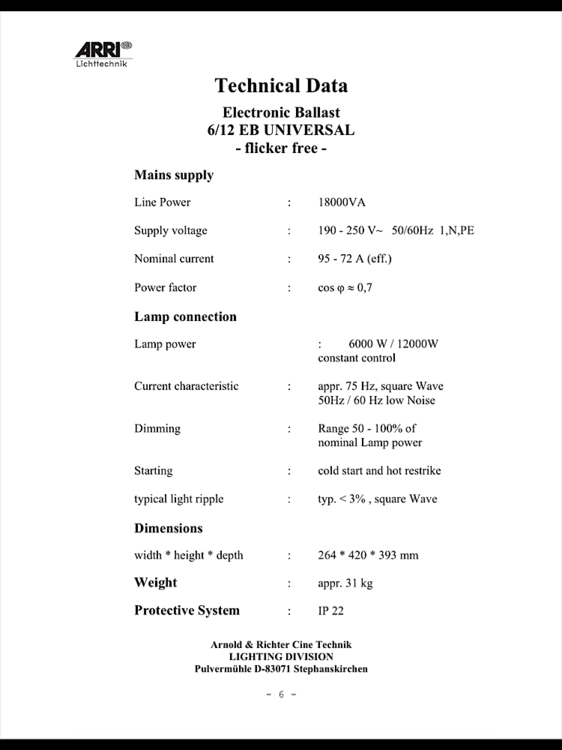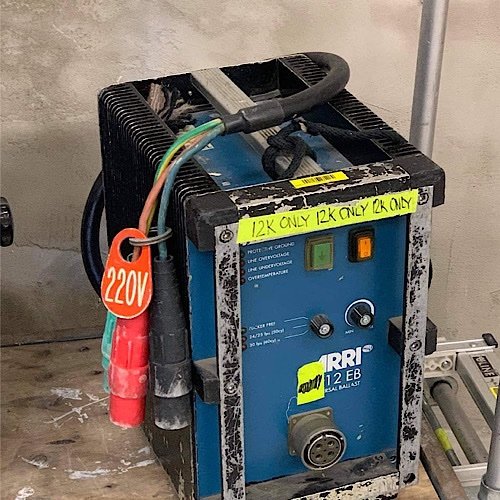
Bradley Mowell
-
Posts
16 -
Joined
-
Last visited
Posts posted by Bradley Mowell
-
-
Guy,
I seriously appreciate the info and will be sure to double my feeders and oversize the power source.
In regard to capturing peak voltage, I’m assuming a clamp meter would be best. Do you have an inexpensive make and model that you recommend?
Also, any idea if the Fluke 41B Power Harmonics Analyzer is a good unit?
-
12 minutes ago, Brian Doran said:
Just chiming in to say that the ballast in the photo is from 1995, about 26 years old. The last two digits on ARRI ballasts represent the year of manufacturing.
Thank you, Brian. Good to know.
-
35 minutes ago, Ed Conley said:
Interesting. The Harry Box tech handbook states that all 12k and above are now PFC but this is Fourth Edition 2013 Edition.
How old is the ballast?
The ballasts are all retired rental stock. I’d guess they’re about 20 years old…definitely pre-4th edition. I bought 1st and 3rd edition copies of Box’s book to try to find more info about these particular ballasts.
35 minutes ago, Ed Conley said:the "excess" power returning on the neutral matters because in a normal load if all phases are balanced then there should be no load on the neutral but w/o PFC things get weird and the neutral will see excess load and you need to factor in this extra load when sizing the cables and the generator.
It still maters when using house power too.
On 240v the excess power still exists.
I’ve read the section(s) on power factor correction in each of the three editions of Box’s book, but what I don’t understand is this:On 240v single-phase house power, how can excess power return on a neutral wire when the ballasts don’t have a neutral wire? ?
-
1 hour ago, Ed Conley said:
I believe that is a PFC ballast though.
I wish it was, Ed. Unfortunately, the plate shows 0,7…and emails with Arri confirm it’s non-PFC (no active line filtering). Unless I’ve misinterpreted what I’ve been told, which is entirely possible.
BTW, thanks a bunch for the advice about a year ago. Worked like a charm, sir.
-
I have four Arri 6/12 electronic ballasts that are non-PFC ( power factor correction ) that operate at 190-250v. Each ballast has a green ground, black hot, and red hot.
I’ve read that non-PFC ballasts return a lot of excess current on the neutral wire because of low power factor (these are rated at 0.7 PF) but how does that apply to ballasts that operate at 190-250v that have no neutral wire? I’m using 240v location power rather than a generator, so how/where does the excess current from a non-PFC ballast return on a neutral wire in the distribution system? I’m assuming all current is “cancelled out” at 240v between the black hot and red hot. But if, somehow, there IS still excess current, where does it go? -
Awesome suggestions, Aapo.
I'll look the bulbs over carefully.
Thank you! And thanks for the pics!
-
Hi, Phil. And thank you for responding.
It's an Arrisun 120 with a 6/12 EB ballast.
These are great suggestions, and much appreciated.
-
I realize I could probably pay to have them checked out at a local rental house, but what if there isn’t a local rental house within a reasonable distance, i.e. a couple hundred miles?
-
What should one watch out for when buying a used, larger HMI par without a warranty?
If the unit strikes fine, what would it be a good idea to check before making the purchase?
Lens and reflector condition? Cable damage? Any particular issues with ballasts? Bulb condition? Etc.
Thanks.
-
Hi,
I purchased a used Arri True Blue T5 tungsten fresnel wired for 220v w/a new 220v bulb. The lens and wire screen are fully intact, and the unit itself appears to be in very good condition.
Do I simply strike it using the inline switch or should I power it up gradually from a dimmer?
Thank you!
-
19 minutes ago, Joseph Tese said:
The other option, is to invest in step-down transformers, which has more advantages.
http://www.screenlightandgrip.com/html/emailnewsletter_generators.html#anchorTransformer/Distros on Wall OutletsThank you. I contacted them a few days ago, and a transformer certainly does have its advantages, but I was shooting for something more portable and less pricey. I think you're suggestion about contacting someone local to build an adapter is a good idea. As I mentioned to Ed, I'm overly-cautious and hesitate to do electrical DIY projects without clear directions and step-by-step pictures. ?
-
4 minutes ago, Ed Conley said:
making an adapter is easy enough.
You start by purchasing a Dryer 4-wire power cord and then attaching female connector on the other end that matches your connectors on the lights.for 120v: Hot ( Red or Black wire) , white, ground.
https://www.homedepot.com/p/HDX-6-ft-4-Wire-Dryer-Replacement-Cord-HD-601-004/202532733Thanks, Ed. Joseph probably has the right idea about consulting with a local electrician to build something for my needs. I'm the cautious type, and without a tutorial or book I'm hesitant to mess with anything electrical (I've installed many a breaker, wired for 240v in my garage, and other electrical projects, but I've always had a clear tutorial to work from - complete with pictures ?). Unless you know something I could reference, probably best to leave it to someone more in-the-know.
-
1 hour ago, Joseph Tese said:
Here's one that will split the phases of a dryer plug. The wire gauge is only rated for 30AMPS. Although it provides (2) 20 Amp outlets on each side, you can only pull 30 amps collectively from each side.
Thanks, for the link, Joseph. However, wouldn't doing it that way mean that each 20amp Edison outlet would only supply 2400 watts to a light? I'm seeking a way to be able to access the full 3600watts from 30 amps to power 2.5k to 3k lights. I apologize for all the questions.
-
1 hour ago, Joseph Tese said:
Are you wanting to power 240v lights? Or, do you want to split the phases so you have two lines at 120v?
Either is possible.
If your dryer plug was only three prong, and had no neutral, then it is unsafe to split the phases because your load will probably not be perfectly balanced.
Thanks, Joseph. Looking to build (or buy) an adapter (the dryer outlets are four prong) to be able to access 30 amps (or 40 amps from the range) for 120v lights. Splitting phases for two lines would be great, but one line would suffice. The dryer outlet is 30 amp / the range is 40 amp.
-
I've read until I'm blue in the face - both here and elsewhere - and still don't understand. Trying to accomplish this:
"There are 220V plugs on dryers. They are similar to our genny connectors here. The dryer connectors have 4 prongs on them. You have a ground and a neutral and then a hot and a hot. You do need to build an adaptor that eliminates one of the hots. You separate the hots out so you have 2 hot connectors on the end of that. That way, you can access all 30 amps... Back in the day, when I was doing a lot of music videos, we made our own connectors that we could tie into these dryer circuits. I was maxing out homes all over in my music video days of the 90s."
How does one go about making/buying an adapter?





Fluke 381 review
in Lighting for Film & Video
Posted
What particular True RMS meter would you recommend, Guy?